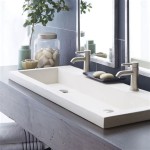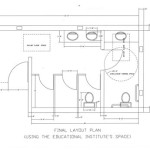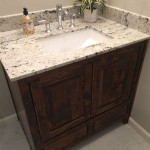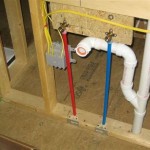Navigating Bathroom Sink Drain Connection Challenges: A Comprehensive Guide
The bathroom sink drain, often an overlooked component, plays a crucial role in the functionality and hygiene of any bathroom. Its primary purpose is to efficiently remove wastewater from the sink, preventing flooding and maintaining a clean environment. The connection points within this drain system, however, can be sources of potential problems if not properly installed or maintained. This article will provide a comprehensive overview of bathroom sink drain connections, focusing on common issues, preventative measures, and troubleshooting techniques.
Understanding the anatomy of a bathroom sink drain is essential for effective maintenance. Typically, the system consists of several key components. The sink drain itself, often made of metal or plastic, sits directly within the sink basin. A tailpiece extends downward from the sink drain, connecting to the P-trap. The P-trap, characterized by its U-shaped design, is a critical component that holds a small amount of water. This water acts as a barrier, preventing sewer gases from entering the bathroom. Finally, the P-trap connects to the drainpipe, which carries wastewater away to the main plumbing system. Each connection point between these components is susceptible to leaks and blockages, requiring careful attention during installation and maintenance.
Key Point 1: Identifying Common Bathroom Sink Drain Connection Issues
Several common issues can arise within the bathroom sink drain connection system. Leaks are perhaps the most frequent problem. These leaks can occur at various points, including the connection between the sink drain and the tailpiece, the joints within the P-trap, or the connection between the P-trap and the drainpipe. Leaks are often caused by loose connections, deteriorated washers or seals, or corrosion of the drain components. Identifying the source of a leak is crucial for effective repair.
Another common issue is blockages. Hair, soap scum, and other debris can accumulate within the drain system, particularly in the P-trap. Over time, this accumulation can restrict water flow and eventually lead to a complete blockage. Signs of a blockage include slow draining water, gurgling noises from the drain, and an unpleasant odor emanating from the sink. Addressing blockages promptly is essential to prevent further complications and potential damage to the plumbing system.
Corrosion is also a significant concern, especially in older plumbing systems. Metal drain components, such as those made of brass or steel, are susceptible to corrosion over time due to exposure to water and chemicals. Corrosion can weaken the drain components, leading to leaks and eventual failure. Regular inspection of the drain system can help identify signs of corrosion early on, allowing for timely replacement of affected parts.
Misalignment of drain components is another contributing factor to connection problems. If the tailpiece, P-trap, and drainpipe are not properly aligned, it can create stress on the connections, leading to leaks and potential damage. This is particularly relevant during installation, where careful attention must be paid to ensuring proper alignment of all components. Using adjustable P-traps can significantly aid in achieving proper alignment, especially in older homes where plumbing may not be perfectly straight.
Finally, improper installation techniques can lead to a range of problems. Over-tightening connections can damage the components, while under-tightening can result in leaks. Using the wrong type of sealant or plumber's tape can also compromise the integrity of the connections. Following manufacturer's instructions and employing proper techniques are crucial for a successful and long-lasting drain connection.
Key Point 2: Preventative Measures for Maintaining Bathroom Sink Drain Connections
Implementing preventative measures is key to ensuring the longevity and proper functioning of bathroom sink drain connections. Regular cleaning is a fundamental step. Flushing the drain with hot water periodically can help prevent the buildup of soap scum and other debris. Pouring boiling water down the drain (with caution, especially with PVC pipes) can also help dissolve grease and prevent blockages. Avoid pouring harsh chemicals down the drain, as these can damage the drain components over time.
Using a drain strainer is another effective preventative measure. A strainer placed over the sink drain can trap hair, food particles, and other debris, preventing them from entering the drain system and causing blockages. Clean the strainer regularly to ensure its effectiveness. These strainers are inexpensive and readily available, making them a practical and cost-effective solution.
Regularly inspecting the drain connections for leaks is also essential. Check under the sink periodically for any signs of water damage or dampness. Inspect the connections between the sink drain, tailpiece, P-trap, and drainpipe for any signs of leaks. If a leak is detected, address it promptly to prevent further damage. Small leaks can often be resolved by tightening the connections or replacing worn washers or seals.
Avoid overloading the drain with excessive amounts of debris. Dispose of food scraps, hair, and other waste materials in the trash rather than washing them down the sink. This simple practice can significantly reduce the risk of blockages and maintain proper drainage.
Properly tightening drain connections during installation or maintenance is crucial. Avoid over-tightening, which can damage the components, and under-tightening, which can result in leaks. Use appropriate tools, such as adjustable wrenches, to tighten the connections securely but not excessively. Refer to the manufacturer's instructions for specific torque recommendations.
Using the right type of sealant or plumber’s tape is vital for creating a watertight seal. Plumber’s tape is typically used on threaded connections, while pipe joint compound (pipe dope) can also be used. Ensure that the sealant or tape is compatible with the drain components and apply it according to the manufacturer's instructions. Proper application of sealant or tape can prevent leaks and ensure a long-lasting connection.
Key Point 3: Troubleshooting Bathroom Sink Drain Connection Problems
When problems arise with bathroom sink drain connections, a systematic approach to troubleshooting is essential. The first step is to identify the specific problem. Is the drain leaking? Is it blocked? Is there a foul odor emanating from the drain?
If a leak is suspected, carefully inspect the drain connections to pinpoint the source. Dry the area around the connections with a cloth or paper towel. Then, run water in the sink and observe where water is leaking from. Once the source of the leak is identified, determine the cause. Is the connection loose? Is a washer or seal damaged? Is the drain component corroded?
For loose connections, try tightening the connection using an adjustable wrench. Be careful not to over-tighten, as this can damage the components. If tightening the connection does not resolve the leak, consider replacing the washer or seal. Ensure that the replacement washer or seal is the correct size and type for the connection.
If corrosion is present, the affected drain component will likely need to be replaced. Disconnect the drain component and inspect it for signs of extensive corrosion. If the corrosion is severe, replacing the entire component is the best solution. Choose replacement components that are made of durable materials, such as brass or PVC, to resist corrosion.
For blocked drains, several troubleshooting techniques can be employed. Start by using a plunger to try to dislodge the blockage. Ensure that there is enough water in the sink to cover the cup of the plunger and apply firm, consistent pressure. If the plunger is not effective, consider using a drain snake or auger. Carefully insert the snake or auger into the drain and rotate it to break up or retrieve the blockage. Be cautious not to damage the drainpipes during this process.
If the blockage is persistent, it may be necessary to disassemble the P-trap. Place a bucket underneath the P-trap to catch any water that may be trapped inside. Loosen the slip nuts that connect the P-trap to the tailpiece and drainpipe. Carefully remove the P-trap and inspect it for any debris or blockages. Clean the P-trap thoroughly and reassemble it, ensuring that the connections are tight.
If a foul odor is emanating from the drain, it is likely due to a buildup of bacteria and organic matter within the drain system. Flushing the drain with a mixture of baking soda and vinegar can help to neutralize the odor. Pour one cup of baking soda down the drain, followed by one cup of vinegar. Allow the mixture to sit for 30 minutes, then flush with hot water. This can help to break down and remove the odor-causing substances. For persistent odors, consider using a drain cleaner that is specifically designed to eliminate odors.
When attempting any drain repair, safety should always be a primary concern. Wear gloves to protect your hands from bacteria and chemicals. If using harsh chemicals, ensure adequate ventilation. Always turn off the water supply to the sink before attempting any repairs that involve disconnecting drain components. If unsure about any aspect of the repair, it is always best to consult a qualified plumber.

Sink Plumbing Flickr Sinks Diy Bathroom Vanity

How To Fit A Bathroom Sink Diy Guides Victorian Plumbing

Keeney 1 4 In Open Grid Bathroom Sink Drain Without Overflow Brushed Nickel K820 74bn The Home Depot

Pattern Stories Bathroom Wallpaper Small Design How To Install

How To Replace And Install A Bathroom Sink

How To Fit A Bathroom Sink Diy Guides Victorian Plumbing

Bathroom Wallpaper How To Install It And More Do S Don Ts Architectural Digest

Keeney 1 4 In Push On Bathroom Sink Drain Without Overflow Polished Chrome K820 76 The Home Depot

Bathroom Wallpaper Ideas Forbes Home
Related Posts







